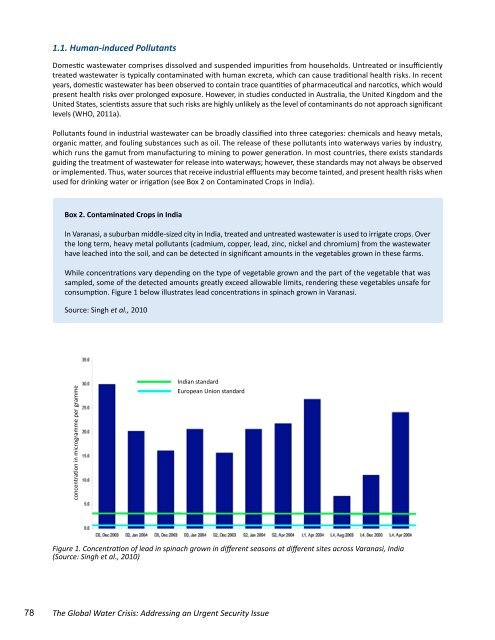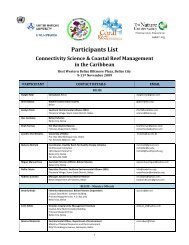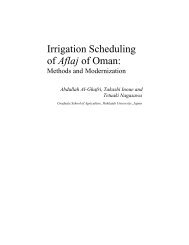The Global Water Crisis: Addressing an Urgent Security - Unu-inweh ...
The Global Water Crisis: Addressing an Urgent Security - Unu-inweh ...
The Global Water Crisis: Addressing an Urgent Security - Unu-inweh ...
You also want an ePaper? Increase the reach of your titles
YUMPU automatically turns print PDFs into web optimized ePapers that Google loves.
1.1. Hum<strong>an</strong>-induced Pollut<strong>an</strong>ts<br />
Domestic wastewater comprises dissolved <strong>an</strong>d suspended impurities from households. Untreated or insufficiently<br />
treated wastewater is typically contaminated with hum<strong>an</strong> excreta, which c<strong>an</strong> cause traditional health risks. In recent<br />
years, domestic wastewater has been observed to contain trace qu<strong>an</strong>tities of pharmaceutical <strong>an</strong>d narcotics, which would<br />
present health risks over prolonged exposure. However, in studies conducted in Australia, the United Kingdom <strong>an</strong>d the<br />
United States, scientists assure that such risks are highly unlikely as the level of contamin<strong>an</strong>ts do not approach signific<strong>an</strong>t<br />
levels (WHO, 2011a).<br />
Pollut<strong>an</strong>ts found in industrial wastewater c<strong>an</strong> be broadly classified into three categories: chemicals <strong>an</strong>d heavy metals,<br />
org<strong>an</strong>ic matter, <strong>an</strong>d fouling subst<strong>an</strong>ces such as oil. <strong>The</strong> release of these pollut<strong>an</strong>ts into waterways varies by industry,<br />
which runs the gamut from m<strong>an</strong>ufacturing to mining to power generation. In most countries, there exists st<strong>an</strong>dards<br />
guiding the treatment of wastewater for release into waterways; however, these st<strong>an</strong>dards may not always be observed<br />
or implemented. Thus, water sources that receive industrial effluents may become tainted, <strong>an</strong>d present health risks when<br />
used for drinking water or irrigation (see Box 2 on Contaminated Crops in India).<br />
Box 2. Contaminated Crops in India<br />
In Var<strong>an</strong>asi, a suburb<strong>an</strong> middle-sized city in India, treated <strong>an</strong>d untreated wastewater is used to irrigate crops. Over<br />
the long term, heavy metal pollut<strong>an</strong>ts (cadmium, copper, lead, zinc, nickel <strong>an</strong>d chromium) from the wastewater<br />
have leached into the soil, <strong>an</strong>d c<strong>an</strong> be detected in signific<strong>an</strong>t amounts in the vegetables grown in these farms.<br />
While concentrations vary depending on the type of vegetable grown <strong>an</strong>d the part of the vegetable that was<br />
sampled, some of the detected amounts greatly exceed allowable limits, rendering these vegetables unsafe for<br />
consumption. Figure 1 below illustrates lead concentrations in spinach grown in Var<strong>an</strong>asi.<br />
Source: Singh et al., 2010<br />
concentration in microgramme per gramme<br />
Indi<strong>an</strong> st<strong>an</strong>dard<br />
Europe<strong>an</strong> Union st<strong>an</strong>dard<br />
Figure 1. Concentration of lead in spinach grown in different seasons at different sites across Var<strong>an</strong>asi, India<br />
(Source: Singh et al., 2010)<br />
78 <strong>The</strong> <strong>Global</strong> <strong>Water</strong> <strong>Crisis</strong>: <strong>Addressing</strong> <strong>an</strong> <strong>Urgent</strong> <strong>Security</strong> Issue




